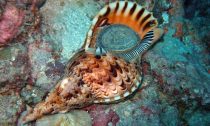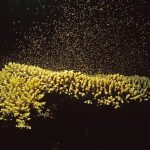
Australia’s Great Barrier Reef is slowly diminishing to death. The coral reef is constantly being attacked by the crown-of-thorns starfish, one of the biggest natural threats to coral reefs. Crown-of-thorns starfish (COTS) has an incredible appetite and can damage coral reefs to the point of extinction. These starfish, Acanthaster planci, feed on live corals only. This animal has several biological attributes that contribute to its ability to undergo massive population fluctuations through time.
Mike Hall, Principal Research Scientist at the Australian Institute of Marine Science, explained how the rarity of the giant triton sea snail may be one reason why the crown-of-thorns is now such a threat to the survival of the Great Barrier Reef.
The scientists from University of the Sunshine Coast in Australia are investigating the potential of COTS to save the coral reefs.
They are investigating the possibility that giant tritons may play a significant role as a natural control agent for COTS outbreaks.
How bad are COTS?
Adult COTS consume up to 10 sq m of coral reef per year. So, just imagine what a population outbreak would do to the coral reefs?
COTS are biological cause of coral loss on world’s most beautiful and rare coral reef, the Great Barrier Reef. COTS are the second destructive power which can cause great damage to the reef after tropical cyclones.
Surprisingly, few predators feed upon the vast coral covered seascapes of the Great Barrier Reef but COTS are an exception.
As corals are fixed in one location, they have no defence against an approaching aggregation of hunting COTS.
Giant tritons, the great saviour:
The giant triton (Charonia tritonis) is one of the world’s largest marine snails reaching a length of up to half a metre.
Due to the beauty of their shell, the giant triton has long been unsustainably harvested from coral reefs, primarily for sale to shell collectors.
While the giant triton was declared a protected species in the 1960s, after a century of heavy fishing pressure, they remain quite rare on the Great Barrier Reef.
They are also known to eat other sea stars and echinoderms such as sea cucumbers.
How effective are these snails?
Giant tritons typically only eat one COTS per week so they have little application in feeding down a population of COTS numbering in hundreds of thousands. However, their very presence in the vicinity of COTS disperses aggregations.
As aggregations are dispersed, and fertilisation success rates decline, the likelihood of massive recruitment in a spawning season may well be reduced.













Social Profiles